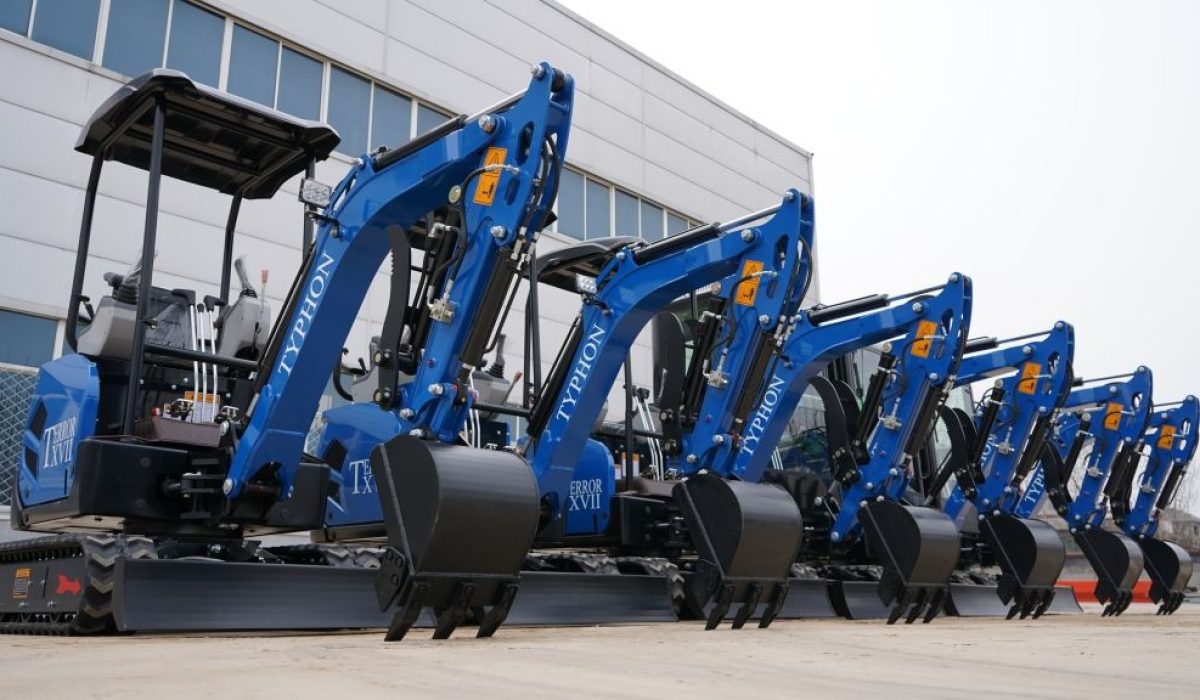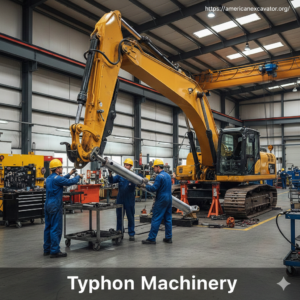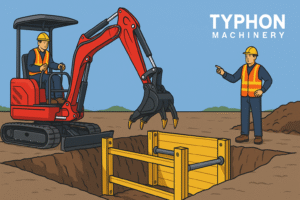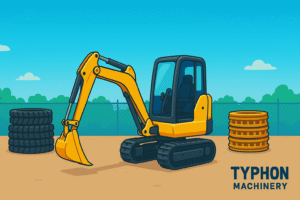Compact excavators — also known as mini excavators — are powerful, versatile machines designed for earthmoving in confined or tight workspaces. Their compact size paired with dig depth, reach, and various attachments make them indispensable across construction, landscaping, utilities, and agriculture.
What Are Compact Excavators?
Compact excavators typically weigh between 1 to 10 metric tons and feature track-mounted chassis with hydraulic-powered booms and arms. They are designed for efficient operation in restricted site conditions such as urban areas, residential yards, and small-scale commercial jobs where larger equipment cannot fit. Thanks to their size, compact excavators are easier to transport and maneuver, yet they maintain impressive digging power and precision.
Key Features of Compact Excavators
-
Size and Weight: Usually categorized by operating weight from 1 up to 10 metric tons, enabling selection based on job scale and site conditions.
-
Swing Radius: Compact tail swing designs minimize rear overhang for tight space operations, improving site mobility.
-
Dig Depth & Reach: Varies by model with typical digging depths from 7 to over 13 feet, adaptable for different excavation tasks.
-
Engine Power: Engines range from about 16 HP in smaller models up to 70+ HP for larger ones, balancing power and fuel efficiency.
-
Hydraulics: Advanced load-sensing hydraulics for smooth, precise control over arm and bucket movements.
-
Attachments: Compatible with a variety of attachments like buckets, augers, breakers, grapples, and thumbs to increase versatility.
-
Operator Comfort: Fully enclosed cabs or open canopy options with ergonomic controls and excellent visibility lessen operator fatigue.
Typical Uses of Compact Excavators
-
Residential foundation digging and landscaping
-
Utility trenching and pipeline installation
-
Demolition of small structures
-
Site preparation in urban and confined environments
-
Agriculture tasks such as irrigation ditches and tree planting
-
Roadside and municipal maintenance work
Benefits of Choosing Compact Excavators
-
High maneuverability allows operation in restricted, hard-to-access locations.
-
Lower ground pressure reduces site damage, important in landscaping and sensitive areas.
-
Fuel efficiency compared to larger excavators cuts operational costs.
-
Easier transport via trailers without heavy hauling permits.
-
Versatile attachments expand capabilities for multiple job types with one machine.
Leading Compact Excavator Brands and Models
Top manufacturers such as Typhon Machinery, Bobcat, Caterpillar, JCB, New Holland, and Volvo offer a wide range of compact excavators tailored to diverse needs. These brands provide options from lightweight 1-2 ton models ideal for tight spaces to 7+ ton machines suited for more demanding commercial projects.
Compact excavators are the go-to solution for efficient, versatile digging and earthmoving in confined spaces. Their combination of power, precision, and portability enables contractors and landscapers to tackle projects that require both reach and agility. Investing in a compact excavator, especially from trusted brands like Typhon Machinery, ensures equipment reliability, productivity, and long-term value.
For businesses and professionals seeking to maximize job-site efficiency with adaptable excavators that fit restricted work zones, compact excavators remain a top asset choice.
Which attachments enhance productivity of compact excavators
Attachments that significantly enhance the productivity of compact excavators include:
-
Quick Couplers: Enable fast and safe switching of attachments without leaving the cab, reducing downtime and improving workflow efficiency.
-
Hydraulic Tilt Couplers (Powertilt and Tiltrotator): Allow buckets and tools to tilt and rotate up to 180° or 360°, increasing versatility and precision. This reduces the need to reposition the excavator, leading to faster and more accurate work.
-
Buckets: Various types such as standard digging buckets, trenching buckets, grading buckets, and ditch cleaning buckets adapt the excavator for different soil types and excavation tasks.
-
Hydraulic Breakers: Powerful attachments for breaking concrete, rock, and asphalt, ideal for demolition and construction site preparation.
-
Hydraulic Thumbs and Grapples: Provide gripping capability for handling irregular shaped materials like logs, debris, and pipes, enhancing material handling efficiency.
-
Augers: Useful for drilling holes for posts, fences, and foundations, speeding up what would otherwise be manual labor-intensive processes.
-
Rippers: Break up compacted soil or hard ground for easier excavation, improving efficiency in tough terrain.
-
Compact Plate Compactors: Attach to the excavator for soil and gravel compaction around foundations or trenches, helping save time compared to manual compaction.
-
Brush Cutters: Used for clearing vegetation and small trees, improving productivity in land clearing and landscaping tasks.
These specialized attachments enable a compact excavator to tackle a wide range of jobs efficiently, transforming it into a versatile tool that maximizes productivity across construction, landscaping, demolition, and utility projects. Operators benefit from reduced manual labor, faster job completion times, and improved precision, making the right attachments an essential investment for optimizing compact excavator use.
What factors should be considered when selecting excavator attachments
When selecting excavator attachments, several important factors should be considered to ensure the right fit, optimal performance, and maximum productivity:
1. Compatibility with Excavator Model
Attachments must be compatible with the specific make and model of the excavator. Consider the machine’s weight, arm length, boom reach, lifting capacity, and hydraulic system specifications (flow rate and pressure). Using attachments that don’t match the excavator’s capabilities can lead to inefficiency, machine strain, or even damage.
2. Type of Work and Materials
Identify the primary tasks the attachment will be used for—digging, trenching, demolition, material handling, grading, or drilling. Different attachments excel for specific materials, for example, buckets for soil, breakers for concrete, or grapples for handling debris.
3. Hydraulic Requirements
Some attachments rely on auxiliary hydraulic functions. It is essential to know whether the excavator has the required hydraulic flow and pressure to operate the attachment smoothly and efficiently. Not all excavators support third or fourth hydraulic functions.
4. Weight and Size
The attachment’s weight must be within the excavator’s lifting and counterweight limits to maintain stability and safety. It should also physically fit the excavator’s arm and coupler system without hindrance.
5. Job Site Conditions
Consider soil type (rocky, sandy, clay), space constraints, and accessibility on the job site. For example, compact attachments are better for tight spaces, while heavy-duty attachments suit rough terrain or demolition.
6. Operator Skill Level
Some attachments like hydraulic breakers or rippers require skilled operation for safety and efficiency. Choose attachments based on the operator’s experience and training.
7. Frequency and Type of Use
For high-frequency tasks, durable and easy-to-maintain attachments are preferable. For occasional use, renting or opting for multi-purpose attachments may be more cost-effective.
8. Quality and Brand Reliability
Invest in attachments from reputable brands known for durability and support to minimize downtime and maintenance costs. Genuine parts and attachments, like those from Typhon Machinery, ensure longevity and compatibility.
9. Versatility and Multi-functionality
Attachments that can serve multiple functions or be adapted for various tasks can enhance job flexibility and reduce the need for frequent swapping.
Considering these factors helps ensure the selected excavator attachments deliver maximum productivity, safety, and cost-efficiency while protecting the investment in the excavator machinery.
What Are the Main Advantages of Compact Excavators?
The main advantages of compact excavators include:
-
Exceptional Maneuverability: Their small size allows operation in tight or congested spaces where larger machines cannot fit, making them ideal for urban construction, landscaping, and utility work.
-
Versatility: Compact excavators work with a wide variety of attachments such as buckets, breakers, augers, and grapples, enabling them to perform multiple tasks like digging, trenching, demolition, grading, and material handling.
-
Cost-Effectiveness: They have lower purchase, rental, fuel, and maintenance costs compared to larger excavators, making them economical choices for small to medium projects.
-
Reduced Environmental Impact: Smaller engines and lighter weight lead to less fuel consumption, lower emissions, and minimal ground disturbance, which is important for sensitive sites and landscaping.
-
Ease of Transport: Compact size and weight allow easy transport on standard trailers without requiring special hauling equipment, saving time and logistics costs.
-
Precision and Control: Their design allows precise digging and grading in confined areas, improving operational accuracy and reducing site disruption.
-
Lower Operating Costs and Maintenance: Smaller components and efficient hydraulic systems reduce downtime and maintenance expenses.
Overall, compact excavators offer a powerful blend of agility, flexibility, and cost savings, which makes them essential equipment for a wide range of construction and landscaping projects.
How does fuel efficiency benefit operating costs of compact excavators
Fuel efficiency directly benefits the operating costs of compact excavators by significantly reducing fuel consumption, which is one of the largest ongoing expenses in machinery operation. Efficient fuel use means longer work hours per tank, lowering the frequency of refueling stops and associated labor or downtime. Reduced fuel use also cuts emissions and often correlates with advanced engine technology that requires less maintenance, further decreasing repair and service costs.
In monetary terms, better fuel efficiency leads to substantial savings especially over long project durations or multiple machines on site. It also enhances sustainability credentials by minimizing environmental impact without sacrificing machine performance or productivity. This balance of lower fuel costs and high operational uptime ultimately drives better profitability for contractors and equipment owners using compact excavators.





